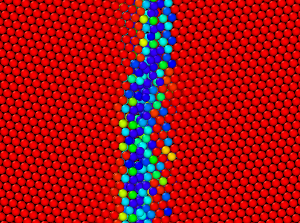Scientific scope and context
Practically all technologically relevant structural materials are polycrystalline, i.e., they consist of a multitude of single crystalline grains which are connected by grain boundaries. The mobility/dynamics of these grain boundaries is a key quantity determining the mechanical properties and the long-term stability of structural materials, in particular by affecting microstructure evolution, aging, or deformation. Only a deep fundamental understanding of the dynamics will enable a tailored material design through optimized microstructure formation and therefore adjusted materials properties. For this reason, experimental as well as theoretical investigations are undertaken to reveal the mechanisms behind grain boundary migration. However, starting with the first molecular dynamics simulations about two decades ago, an unexpectedly large discrepancy between experimentally measured and theoretically simulated energy barriers and migration rates became apparent. This discrepancy has hindered so far developing a clear fundamental, atomistically based understanding of the grain boundary dynamics. Novel theoretical developments in conjunction with increasingly powerful supercomputers have recently allowed to scrutinize previously unavoidable assumptions and provided first insights into new and so far unanticipated mechanisms.
The general scope of our international workshop is therefore to bring together the worldwide leading experts in the field of grain boundary migration, in order to allow the exchange of the most recent, theoretical as well as experimental approaches and results to foster new ideas and future concepts. The workshop will cover various aspects of grain boundary physics from a theoretical and experimental perspective: structure, energetics, and migration kinetics with a specific focus on the atomistic mechanisms causing grain boundary mobility. The renowned invited speakers will present ideas and concepts in 45 min presentations (30 min talk + 15 min discussion). Other contributions will be introduced in a poster flash session (about 5min per contribution) and subsequently discussed in detail at the corresponding poster. In this way, our workshop will provide the opportunity for junior scientists to meet and discuss state-of-the-art methods and results with leading scientists in this scientifically and technologically exciting field.

